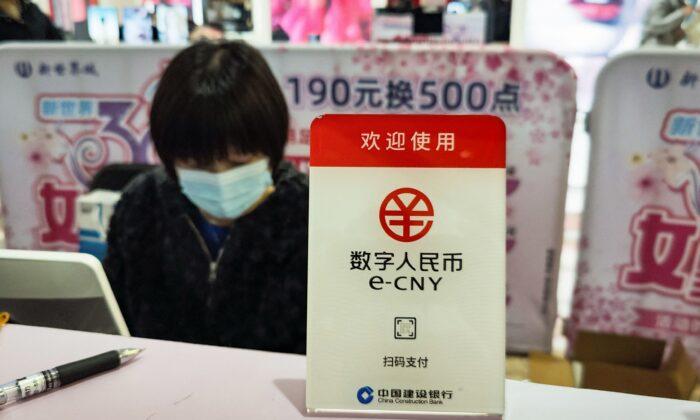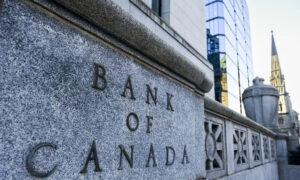The widespread implementation of a central bank digital currency (CBDC) would require a degree of government control that’s similar to what the Chinese communist regime has over its citizens, a former chief economist for the Senate Banking Committee says.
“If a government is going to introduce this new electronic currency system, there are only two ways that it would be widely used,” said Thomas Hogan, a senior fellow at pro-free market think tank American Institute for Economic Research in an interview on EpochTV’s “Crossroads.”
“One is, if it’s a really good system and people want to use it. We haven’t seen that anywhere,” the economist told host Joshua Philipp. “The other way is that, if they [the governments] are so forceful and so powerful, like in the case of China, they can essentially force the citizens to use it.”
A total of 130 countries representing 98 percent of the global economy are taking steps to convert their central bank money into digital form, according to a recent report by Washington-based think tank Atlantic Council. That’s a dramatic increase from two years ago, when just 35 countries were exploring a CBDC.
Some 11 of those 130 countries have already launched their CBDCs. All of them, except Nigeria, are Caribbean island nations.
All G20 countries, with the exception of Argentina, are now in the advanced stage of CBDC development. In China, a pilot digital renminbi program is being tested in more than 200 scenarios, from public transit to government stimulus payments to e-commerce.
Russia, amid what it calls a special military operation against Ukraine, announced that it would launch a CBDC pilot in April. After a series of delays due to legislative changes, the Bank of Russia said it will finally begin real-world tests of the digital ruble with 13 banks and limited clients on Aug. 15, with a goal to open it to all citizens and businesses in 2025.
“Once they are offering the public these digital currencies, the central bank has some information about what the public is doing, what they’re spending their money on, and has some control about what people are and aren’t able to spend their money on,” Mr. Hogan said.
Outlook for Fed’s Digital Dollar
The Federal Reserve’s work on a retail CBDC has largely stalled, although it’s still moving forward with a wholesale CBDC that can be used by financial institutions for bank-to-bank transfers.“Traditional transfers between banks take a long time. You have to wait several days,” Mr. Hogan stated. With a CBDC, “this is now a system where you can transfer money 24 hours a day, seven days a week, and you don’t have to wait a long time.
“Of course, part of the reason that they have to wait is legal issues that have nothing to do with actual technology itself. So even though this technology is a little bit more efficient, it’s not clear that there’s a big benefit there.”
When asked why the Fed is interested in replacing physical paper banknotes with digital dollars, Mr. Hogan said this would, first of all, give the central bank much greater flexibility in controlling the amount of money in circulation.
“Typically, the Federal Reserve manages the money supply by buying and selling bonds and raising and lowering interest rates,” he said. “Rather than buying and selling bonds and putting money into financial markets, they could just directly inject that money into people’s bank accounts with the central bank digital currency.
“However, that would also mean they would have the ability to take money out of people’s bank accounts,” he added. “It also, as we said, gives them more control to monitor what people are doing with their money.”
As this point, according to the former Senate economist, a digital U.S. dollar remains more of an idea, since the federal government doesn’t have as much top-down control as China does.
Fed Chair’s CBDC Testimony
In March, during a hearing before the House Committee on Financial Services, Fed Chair Jerome Powell said it would “absolutely be the case” that a retail CBDC needs congressional approval before it could be offered to Americans. He also said the central bank isn’t “at the stage of making any real decisions” about things such as the potential architecture of a digital dollar.While that may sound assuring, it doesn’t mean people’s concerns over the government-driven push for a cashless society aren’t valid, Mr. Hogan said.
“This push has been going on for decades already to get people away from cash and to take away their ability to use cash, so that the government can have more control over their transactions,” he said, noting that idea of ditching cash for digital money is based on two false assumptions.
“One is that people who only use cash are criminals, which is definitely not true,” he said. “It also assumes that the government is trustworthy in managing all those payments and managing your information. And they’ve proven that they can’t do it.”
As an example, Mr. Hogan pointed to the Canadian truckers’ anti-COVID vaccine mandate protests in 2022, to which the Canadian government responded by locking not only the bank accounts of the protesters but also those of people who donated to the cause.
“We’ve seen that the government will take it upon themselves to use that power in a way that’s good for them, but not good for the people,” he said. “It’s dangerous to want to give them that power.”
Speaking of Mr. Powell’s remark, Mr. Hogan said people may find it comforting, but at the end of the day, it could just very well be the Fed chief’s personal opinion.
“What we’ve seen over the last couple of years in the pandemic recovery is the Fed going beyond what people thought it was legally allowed to do,” he said. “So it’s not very comforting that’s just his opinion, considering the bailouts they did to state and local governments and to non-bank financial companies in the pandemic recovery. Those are things the Fed is not allowed to do but did anyway.
“On one hand, it’s comforting that Powell would say that. On the other hand, he could change his mind, or we might have political pressure to replace him with someone who would be willing to have the Fed go into areas they’re really not supposed to be in.”








